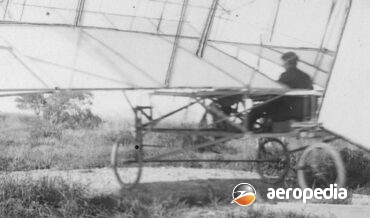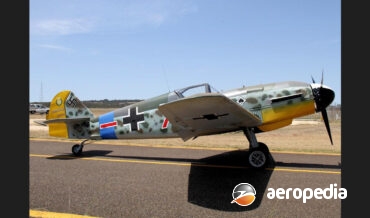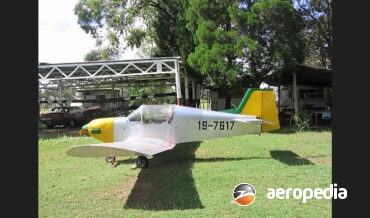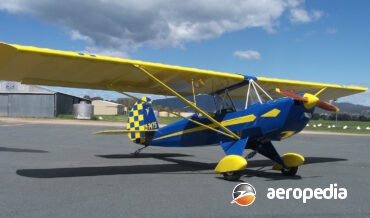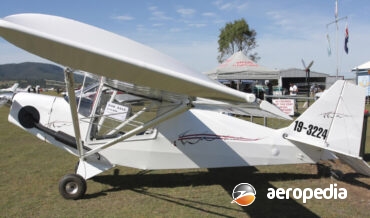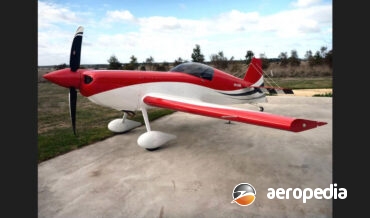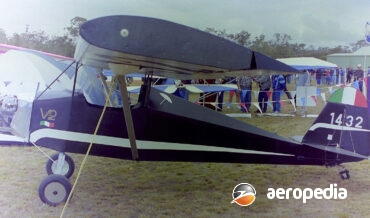David C. Eyre
Records indicate Mr J C Orrock of Endiena, SA, built a light aircraft in 1928. Little is known about the aircraft and it is not known if it was completed or flown.
David C. Eyre
- May 25, 2020
This one-off design was first registered as 10-0068 on 8 April 1988 and operated for a period until withdrawn from use.
David C. Eyre
- May 25, 2020
In 1908 Bertram Ogilvie, a resident of Napier on the north island of New Zealand, with the assistance of Messrs R Goodger, J Munro, H Suckling and other local friends, commenced the construction of a biplane of his own design.
David C. Eyre
- May 25, 2020
The Normoyle Mk I, one example of which has been completed as 19-3669, is an Austflight Drifter built by Patrick Normoyle in South Australia, his aircraft looking much like the Drifter but has some major modifications, particularly to the nose and windshield area.
David C. Eyre
- May 25, 2020
The Skitz was a one-off homebuilt light aircraft designed and built by Robert Noble and was registered as 19-3937 (c/n 6) on 1 July 2003 with Recreation Aviation Australia.
David C. Eyre
- May 25, 2020
Also known as the Owen Dull Gyrocopter, this company based at Roadvale, Qld has built a number of single and two-seat gyrocopters for the Australian market, including G-121, G-132, G-153, and G-241, the latter being similar in appearance to a RAF 2000.
David C. Eyre
- May 25, 2020
This aircraft was a light parasol-wing light aircraft built and flown in the 1930s in the Newcastle area.
David C. Eyre
- May 25, 2020
The P-51B is a two-thirds scale replica of the North American P-51B World War II fighter and is of all-metal construction and designed and built in Australia.
David C. Eyre
- May 25, 2020
In 1925 George Murray of Goulburn, NSW, a carpenter, commenced construction of a small aircraft powered by a twin-cylinder converted motor-cycle engine.
David C. Eyre
- May 25, 2020
Mr Howard Morris, a commercial pilot, in the late 1930s showed some interest in aviation and built a half-size non-flying replica of a Mignet Pou de Ciel (Flying Flea).
David C. Eyre
- May 25, 2020
Initially based in Sydney, Gary Morgan has been involved in the design of light aircraft for many years and this culminated in the design and production of the kit aircraft named the Cheetah, Cougar and Cheyenne.
David C. Eyre
- May 25, 2020
This aircraft was a one-off design by Douglas McIlwraith based in Biddaddaba, Qld who initially wished to build a replica of a Monocoupe and in the end built a biplane of his own design fitted with a six-cylinder Jabiru engine providing 89-kw (120-hp), this engine being fitted with liquid-cooled heads.
David C. Eyre
- May 25, 2020
The Mp3 was an Australian designed and built light single-seat light aircraft and was produced in the 1980s for the local market.
David C. Eyre
- May 25, 2020
The Minimoth was a light sporting biplane design for the sport pilot developed and marketed in the late 1970s. It was of wooden construction with fabric covering.
David C. Eyre
- May 25, 2020
This is a company which designs and builds to military grade powered paragliding trikes for military use, border security and law enforcement applications.
David C. Eyre
- May 25, 2020
Over the years a small number of scale replicas, usually 75%, of the Bf 109 have been privately built from scratch in Australia.
David C. Eyre
- May 25, 2020
Ronald Mellow, a resident of Queensland, in the 21st Century has designed and built two light aircraft. The second [registration 19-7817] was of all metal construction and was a low-wing monoplane with an enclosed cockpit and fitted with a single-ignition Volkswagen conversion [1835-cc].
David C. Eyre
- May 25, 2020
The Firstar is a two-seat, low-wing monoplane with a tailwheel undercarriage built in the amateur built category.
David C. Eyre
- May 25, 2020
The ASW-20 was designed by Gerhard Walbel and built by Alexander Schleicher GmbH & Co in Germany, Some 765 were built by the Company in Germany and a further 140 were completed in France by Centrair.
David C. Eyre
- May 25, 2020
In 1930 Lawrence Schaeffer of Loxton, SA commenced construction of a two-seat parasol wing monoplane to be fitted with a converted Dodge four-cylinder motor car engine.
David C. Eyre
- May 25, 2020
This was a one-off ultra-light amphibian built it is believed in Queensland, the prototype was completed becoming 19-4649 (c/n 3) and it was registered on 12 April 2006.
David C. Eyre
- May 25, 2020
The Sunbird was designed and built by Michael Roodt and is a two-seats in tandem light parasol-wing aircraft with an open cockpit.
David C. Eyre
- May 25, 2020
Azor Robinson and Alexander Porter, both of Albury, in 1912 built a single-engine aircraft along the lines of a Bleriot and it was flown on a number of occasions at Bongowanna Park, the first flight being recorded as 27 July 1913.
David C. Eyre
- May 25, 2020
The Corella is a single-seat light sporting aircraft with a high-wing and a tailwheel undercarriage. Registered with RAA on 1 September 1999 as 19-3224 (c/n 1) it is described as a Glenda Rickard Corella.
David C. Eyre
- May 25, 2020
Mr G S Richardson in 1900 moved to the town of Penguin in Tasmania in 1900 and built and operated a small cordial drink facility.
David C. Eyre
- May 25, 2020
Replicraft, an American company, has produced plans to build scale replicas of the SPAD VII, SPAD XII, Roland D.VI, Hanriot HD.1, Sopwith Pup, Thomas Morse, Fokker D.VII, Sopwith Camel, Sopwith Triplane, RAF SE.5a and the Sopwith Snipe.
David C. Eyre
- May 25, 2020
This was an attempt to build a man-powered aircraft by a Mr Ranford in Western Australia. Little is known about it but at one stage it was placed on display at the WA Aviation Heritage Museum at Bull Creek, WA but after sometime was removed and placed into storage.
David C. Eyre
- May 25, 2020
In mid 1926 Mr Edwin Prosser of Rockhampton, Qld enquired of the Comptroller of Civil Aviation if it was necessary to obtain a Certificate of Airworthiness for a light aircraft, indicating he was building a monoplane.
David C. Eyre
- May 25, 2020
Little is known about this one-off aircraft but it was registered with the RAA as 19-4671 (c/n 60001) on 6 December 2000 and was withdrawn from service on 7 May 2011.
David C. Eyre
- May 25, 2020
The PP-108 is a single-seat high-performance low-wing monoplane designed and built by Peter Prendergast of Ocean Grove Vic for high-performance aerobatics. It received its C of A on 11 March 2016 and was first registered on 29 February 2016 as VH-XSK (c/n 0015).
David C. Eyre
- May 25, 2020
The Maya Ultralight was a single-seat ultralight aircraft aircraft with an enclosed cabin and powered by a 21-kw (28-hp) Konig SD-570 four-cylinder engine with an adjustable propeller.
David C. Eyre
- May 25, 2020
In 1909 Messrs John Pechugin, a mechanical engineer and draftsman, and Henry Little, a foreman boilermaker, designed and built an aeroplane and are reported to have conducted secret trials of this aircraft on the Basic Reserve in Wellington.
David C. Eyre
- May 25, 2020
This was an aircraft said to be built by Frank Peacock at Burwood, NSW in 1914. It was powered by a 21-kw (28-hp) engine but very little more is known about it and no record of a successful flight has been found.
David C. Eyre
- May 25, 2020
Light homebuilt constructed in the Broken Hill / Ivanhoe, NSW area in the 1930s. Of similar appearance to a Comper Swift, it was fitted with a small radial engine, possibly a seven-cylinder Pobjoy or Siemens unit.
David C. Eyre
- May 25, 2020
The Cygnet was a minimum ultra-light aircraft built in the 1970s. It was built of 4130 aluminium welded frame, had a high wing and an engine in a pusher configuration behind the pilot.
David C. Eyre
- May 25, 2020
This was a one-off ultralight aircraft built by its designer / owner which was registered on 11 February 1994 as 10-1432 (c/n 1432) and is painted dark blue with white trim, a tailwheel undercarriage and a parasol wing with single struts.
David C. Eyre
- May 25, 2020
Sydney Nelson Staff at Harris Park, near Parramatta, NSW, built an aircraft of his own design, the machine being complete by 18 July 1910.
David C. Eyre
- May 25, 2020
The Sportair was a single-seat kit-built ultralight fitted with a 37-kw (50-hp) Rotax 503 engine. It had a cruising speed of 139 km/h (86 mph) and a stalling speed of 56 km/h (35 mph).
David C. Eyre
- May 25, 2020
The Swift was a single-seat light sporting monoplane developed and marketed in the 1960s in Australia and saw some success. It was powered by a Cuyuna engine which produced 22-kw (30-hp).
David C. Eyre
- May 25, 2020
The Sundowner was one of a series of aircraft produced by Sport Aircraft for the ultra-light market.
David C. Eyre
- May 25, 2020
Recent Comments
Archives
Categories
- No categories
Categories
- No categories
Latest Posts
Newsletter



